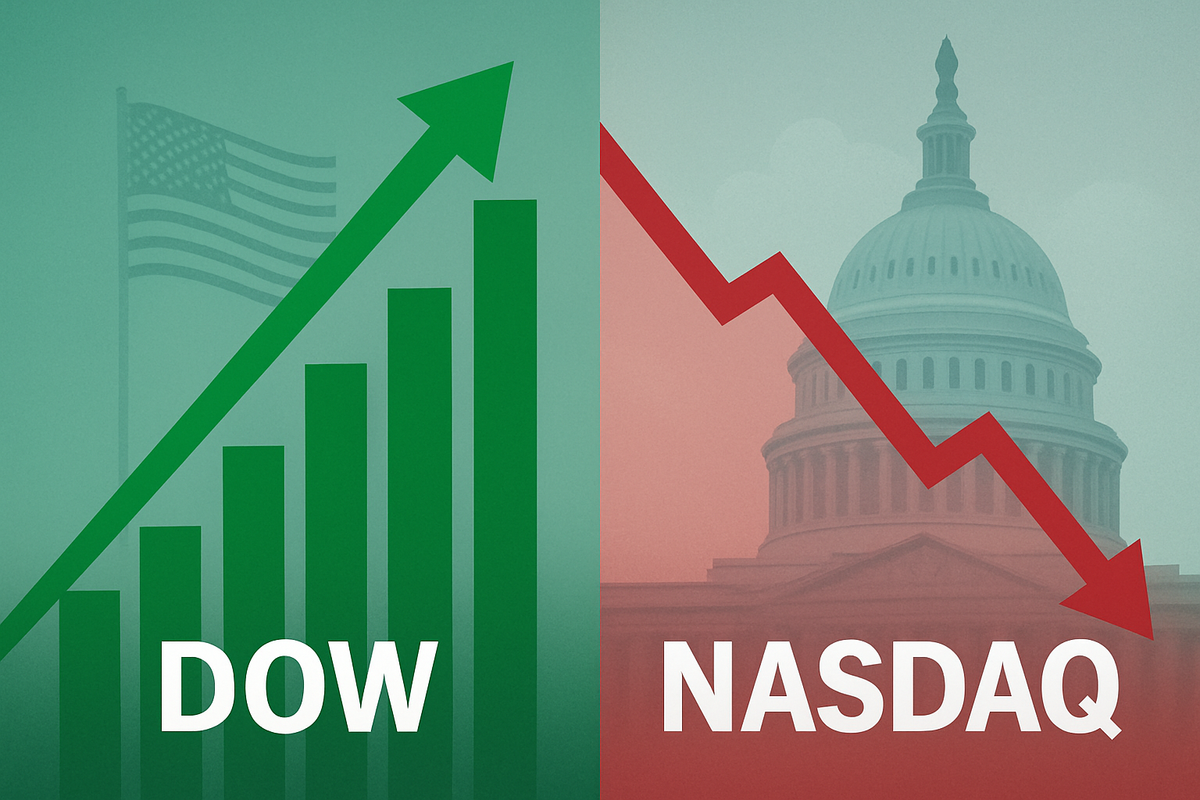
November 12, 2025 – The U.S. financial markets are experiencing a significant shift as optimism surrounding the imminent end of a protracted government shutdown has sent the Dow Jones Industrial Average (DJIA) surging to a new all-time high. This surge reflects a collective sigh of relief from investors, eager to see a return to political stability and a resumption of normal economic functions. However, the tech-heavy Nasdaq Composite has shown a more subdued reaction, slipping amidst profit-taking and a re-evaluation of high-growth stock valuations, signaling a nuanced market landscape.
The divergence between these key indices underscores a broader market recalibration. While the end of the shutdown removes a major cloud of uncertainty, allowing capital to flow back into traditional, value-oriented sectors, it simultaneously prompts investors to reassess the sustainability of recent rallies in the technology sector, particularly those fueled by artificial intelligence (AI) enthusiasm. This "tale of two markets" highlights a cautious optimism, where fundamental economic recovery is celebrated, but speculative growth is viewed with a more critical eye.
The End of Uncertainty: A Detailed Look at the Shutdown's Resolution
The recent U.S. government shutdown, which had gripped the nation for several weeks, stemmed from a deep political deadlock over budgetary allocations and policy disagreements. While the specific details of this particular shutdown are still unfolding, it followed a pattern seen in previous impasses, where critical government services were curtailed, federal employees furloughed or forced to work without pay, and the release of vital economic data was halted. The economic uncertainty created by such a standoff invariably weighs heavily on business and consumer confidence.
The path to resolution, though protracted, gained significant momentum in recent days as key players in Congress and the White House intensified negotiations. Reports of bipartisan breakthroughs on a temporary funding bill, or a more comprehensive spending package, began to circulate, gradually building investor confidence. The final agreement, though yet to be fully detailed, appears to have averted a more severe economic fallout, allowing government agencies to resume full operations. This resolution has been treated as a "de-risking event" by market participants, unleashing pent-up demand for risk assets and driving the broad market rally, even as sector-specific concerns emerged. The cessation of disruptions, such as those to air travel or federal regulatory processes, served as a powerful catalyst for lawmakers to find common ground, demonstrating the tangible impact of prolonged gridlock.
Navigating the Currents: Winners and Losers in a Reopening Economy
The conclusion of the government shutdown and the subsequent market movements are creating distinct winners and losers across various sectors, reflecting both renewed confidence and strategic shifts in investment.
Government contractors are among the most immediate beneficiaries. Companies like Lockheed Martin (NYSE: LMT) and Raytheon Technologies (NYSE: RTX), which rely heavily on federal contracts, faced payment delays and project halts during the shutdown. With funding streams restored, these firms are poised for a strong rebound as delayed projects move forward and new solicitations resume. Similarly, IT service providers to federal agencies, such as CACI International (NYSE: CACI) and Booz Allen Hamilton (NYSE: BAH), are expected to see a surge in activity as agencies work to clear backlogs.
Financial institutions, including titans like JPMorgan Chase (NYSE: JPM) and Bank of America (NYSE: BAC), are also thriving in this environment. Increased market stability, heightened investor confidence, and the anticipation of a more predictable economic landscape contribute to their positive performance. The broader industrial sector, represented by companies like Caterpillar (NYSE: CAT) and Boeing (NYSE: BA), is benefiting from renewed optimism for economic normalization and the unfreezing of government-related spending on infrastructure and defense. Consumer discretionary companies, such as Marriott International (NASDAQ: MAR) and Starbucks (NASDAQ: SBUX), are also expected to see an uptick in business as consumer confidence rebounds and discretionary spending increases after a period of uncertainty.
Conversely, the tech-heavy Nasdaq's slip indicates a period of profit-taking and re-evaluation for high-flying technology and AI stocks. Companies like Nvidia (NASDAQ: NVDA), Advanced Micro Devices (NASDAQ: AMD), and Palantir Technologies (NYSE: PLTR), which have seen significant gains driven by AI enthusiasm, are facing headwinds. Concerns about elevated valuations and a rotation of capital towards more traditional, value-oriented sectors are prompting investors to diversify beyond the concentrated AI segment. News of major investors trimming stakes in prominent tech companies, or AI cloud computing firms revising revenue forecasts, can further dampen sentiment in this sector, even as the broader market celebrates the end of the shutdown.
Broader Implications: A Shift in Market Dynamics and Policy Scrutiny
The resolution of the government shutdown, coupled with the contrasting performance of the Dow and Nasdaq, carries significant broader implications for market dynamics, industry trends, and policy considerations. This event highlights a clear trend of sector rotation, where capital is shifting from high-growth technology stocks, which have dominated market gains for an extended period, towards more established and cyclically sensitive sectors. This rotation is driven by a combination of renewed confidence in the broader economy and a growing scrutiny of "overheated tech valuations," particularly in the AI space.
The ripple effects are far-reaching. While government contractors and sectors tied to federal spending will see immediate benefits, businesses reliant on government permits, licenses, or regulatory approvals will face backlogs as agencies work to catch up. Globally, stock markets often rally on news of a U.S. shutdown ending, reflecting a return of confidence in the world's largest economy. However, the U.S. dollar may experience some weakness as safe-haven demand diminishes. The recurring nature of these shutdowns, despite their temporary economic impact, continues to underscore systemic political risks that can influence long-term investment strategies and potentially deter foreign direct investment.
From a regulatory and policy perspective, the immediate aftermath involves the resumption of all federal services and, crucially, the release of delayed economic data. This data, including vital reports on employment, inflation, and retail sales, is indispensable for the Federal Reserve to make informed decisions on monetary policy, particularly regarding the timing of potential interest rate adjustments. While the immediate crisis is averted, the underlying fiscal and policy divisions that led to the shutdown often remain unresolved, setting the stage for potential future impasses. Historical precedents show that while shutdowns cause short-term volatility, the market's long-term drivers, such as economic growth and corporate earnings, typically prevail. However, the repeated disruptions can erode trust and efficiency in government operations.
The Road Ahead: Navigating a Post-Shutdown Market
As the U.S. economy moves beyond the immediate shadow of the government shutdown, both short-term and long-term possibilities emerge, requiring strategic adaptation from companies and careful observation from investors. In the short term, a "relief rally" is expected to continue, particularly for sectors that were directly impacted by the shutdown's uncertainty. The resumption of economic data releases will be paramount, providing the Federal Reserve with the necessary insights to clarify its monetary policy stance, including any potential interest rate adjustments.
Looking further ahead, while the direct economic impact of most shutdowns tends to be temporary and largely recouped, persistent political gridlock can erode long-term investor confidence and potentially deter corporate investment. Companies will need to build greater resilience into their operations, particularly those with significant government exposure. This includes diversifying revenue streams, maintaining robust cash reserves, and developing contingency plans for future periods of government disruption. Strategic pivots might also involve a continued focus on leveraging private-sector data and alternative indicators to navigate potential future data gaps caused by political impasses.
Market opportunities may emerge in value-oriented and cyclical sectors, which could see sustained interest as investors rotate out of high-valuation tech stocks. Challenges persist for the technology sector, which may face ongoing scrutiny regarding valuations and the sustainability of recent growth, especially in the AI space. Potential scenarios for the coming months include a continued rebalancing act, with financials, industrials, and healthcare sectors potentially outperforming, while the tech sector experiences more tempered growth or consolidation. The global economy will also benefit from reduced U.S. uncertainty, potentially leading to renewed risk-on momentum in emerging markets.
A New Chapter: Market Resilience Amidst Political Realities
The resolution of the U.S. government shutdown and the subsequent market reaction mark a new chapter for investors, defined by a renewed sense of stability but also a discerning eye on sector performance. The key takeaway is the market's inherent resilience; while political disruptions create volatility, the fundamental drivers of economic growth and corporate earnings tend to assert themselves over the long term. The Dow's ascent to new highs underscores this underlying strength and investor confidence in the broader economic recovery.
Moving forward, the market will likely continue its re-evaluation, balancing the optimism of a reopened government with a more critical assessment of individual sector valuations. The lasting impact of this event is less about permanent economic damage and more about highlighting the critical interplay between political stability and market sentiment, as well as the essential role of transparent economic data for informed decision-making.
Investors in the coming months should closely monitor the stream of newly released economic data—particularly inflation reports, employment figures, and retail sales—as these will heavily influence the Federal Reserve's actions. Corporate earnings reports and forward-looking guidance, especially from technology companies, will be crucial in assessing the sustainability of growth narratives. Finally, continued observation of sector performance and capital flows will indicate whether the current rotation into value and cyclical stocks is a temporary adjustment or the beginning of a more sustained trend. The market has weathered the storm, but vigilance remains key in navigating the evolving landscape.
This content is intended for informational purposes only and is not financial advice





